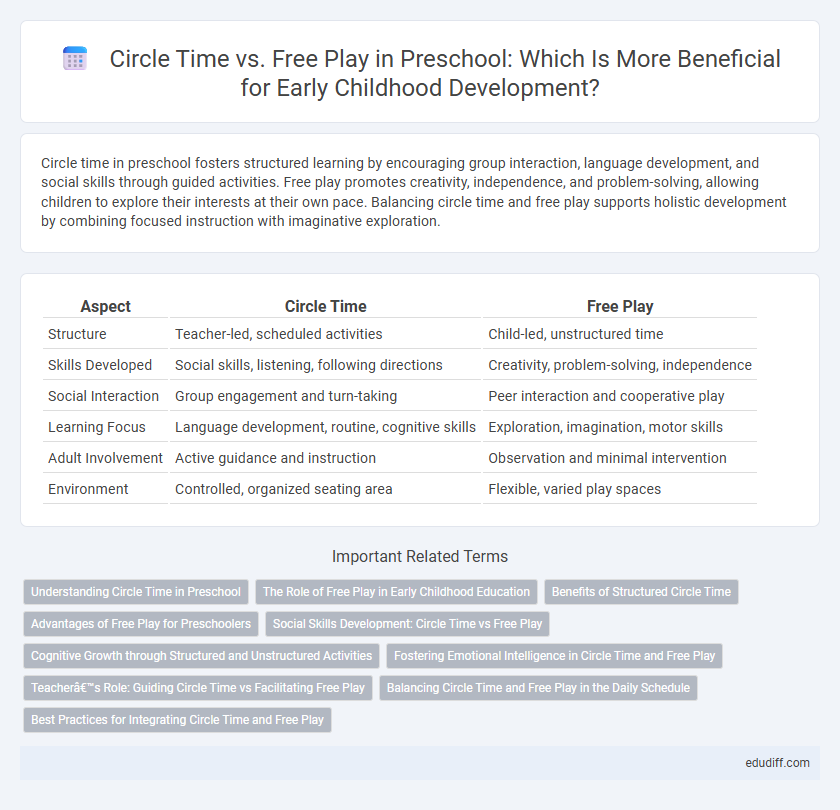Circle time in preschool fosters structured learning by encouraging group interaction, language development, and social skills through guided activities. Free play promotes creativity, independence, and problem-solving, allowing children to explore their interests at their own pace. Balancing circle time and free play supports holistic development by combining focused instruction with imaginative exploration.
Table of Comparison
| Aspect | Circle Time | Free Play |
|---|---|---|
| Structure | Teacher-led, scheduled activities | Child-led, unstructured time |
| Skills Developed | Social skills, listening, following directions | Creativity, problem-solving, independence |
| Social Interaction | Group engagement and turn-taking | Peer interaction and cooperative play |
| Learning Focus | Language development, routine, cognitive skills | Exploration, imagination, motor skills |
| Adult Involvement | Active guidance and instruction | Observation and minimal intervention |
| Environment | Controlled, organized seating area | Flexible, varied play spaces |
Understanding Circle Time in Preschool
Circle Time in preschool is a structured group activity designed to enhance social skills, language development, and cognitive abilities through guided interaction. During Circle Time, children engage in songs, stories, and discussions that promote listening, cooperation, and focused attention. This intentional routine contrasts with free play by providing a supportive environment for developing foundational academic and interpersonal skills.
The Role of Free Play in Early Childhood Education
Free play serves as a crucial component in early childhood education by fostering creativity, social skills, and problem-solving abilities in preschoolers. Unlike structured circle time, free play allows children to explore their interests at their own pace, promoting cognitive and emotional development through hands-on experiences. Research indicates that integrating ample free play opportunities enhances language acquisition and supports self-regulation, making it essential for holistic growth during the preschool years.
Benefits of Structured Circle Time
Structured circle time in preschool enhances language development by promoting vocabulary growth and listening skills through guided discussions. It fosters social-emotional learning by encouraging cooperation, patience, and turn-taking in a controlled environment. Consistent routines during circle time improve attention span and prepare children for future classroom expectations.
Advantages of Free Play for Preschoolers
Free play in preschool fosters creativity, social skills, and decision-making by allowing children to explore interests independently and interact freely with peers. This unstructured environment encourages problem-solving and emotional development, promoting self-confidence and adaptability. Research shows that children engaged in free play exhibit enhanced cognitive flexibility and better cooperation skills compared to solely structured activities like circle time.
Social Skills Development: Circle Time vs Free Play
Circle time promotes social skills development by encouraging turn-taking, active listening, and group communication, fostering cooperation among preschoolers. Free play allows children to practice social interactions in a natural setting, enhancing empathy, conflict resolution, and creativity through spontaneous peer engagement. Balancing structured circle time with unstructured free play maximizes opportunities for comprehensive social skills growth in early childhood education.
Cognitive Growth through Structured and Unstructured Activities
Circle time offers structured cognitive growth by promoting language development, memory skills, and social interaction through guided activities. Free play fosters creativity, problem-solving, and executive function by allowing children to explore and make decisions independently. Balancing both structured circle time and unstructured free play optimizes preschoolers' cognitive development by supporting diverse learning modalities.
Fostering Emotional Intelligence in Circle Time and Free Play
Circle time fosters emotional intelligence by encouraging children to express feelings, listen actively, and practice empathy through guided group discussions and storytelling. Free play enhances emotional skills by allowing children to navigate social interactions, resolve conflicts independently, and develop self-regulation in a natural, unstructured environment. Both settings complement each other, creating a balanced approach to building emotional awareness and interpersonal skills in preschoolers.
Teacher’s Role: Guiding Circle Time vs Facilitating Free Play
The teacher's role during circle time involves structured guidance, directing group activities that promote social skills and focused learning through songs, stories, and discussions. In contrast, facilitating free play requires the teacher to observe, support exploration, and encourage creativity without overt control, allowing children to make choices and develop problem-solving skills. Effective early childhood education balances these roles to foster both cognitive development and autonomous social interaction.
Balancing Circle Time and Free Play in the Daily Schedule
Balancing circle time and free play in the daily preschool schedule supports cognitive development and social skills equally. Allocating 20-30 minutes for structured circle time fosters language, listening, and group interaction, while 60-90 minutes of free play encourages creativity, decision-making, and physical activity. Integrating both activities creates a holistic environment that addresses varied learning styles and developmental needs.
Best Practices for Integrating Circle Time and Free Play
Balancing circle time and free play in preschool optimizes early childhood development by combining structured learning with creative exploration. Implementing short, engaging circle time sessions followed by open-ended free play allows children to reinforce social skills, language development, and cognitive growth. Educators enhance outcomes by observing individual interests during free play to inform thematic circle time activities, fostering a seamless integration of guided instruction and child-led experiences.
Circle time vs Free play Infographic

 edudiff.com
edudiff.com